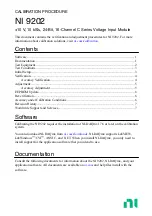
Revision C August 2014
www.trinityhighway.com
33
All rights in copyright reserved
Maintenance and Repair
The QuadGuard
®
CEN is considered to be a potentially reusable system. The system must be
inspected after each impact and must be manually pulled out to its original length. Depending
on the impact, components may get damaged and need replacement.
Important:
After an impact, always follow the “Post-Impact Instructions” in the
maintenance and repair section of this Manual (see p. 34).
Inspection Frequency
Inspections are recommended as needed based upon volume of traffic and impact history.
Visual Drive-By Inspections are recommended at least once a month. Walk-Up Inspections are
recommended at least once a year for QuadGuard
®
CEN systems on asphalt.
Visual Drive-By Inspection
1) Check to see if there is evidence of a hit. If so, a walk-up inspection will be necessary.
2) Check to see if the Cartridges appear to be off the Support Brackets. Any damaged
Cartridges will need to be replaced.
Warning:
See Cartridge placement.
3) Be sure the Nose Belt is in place.
4) Note the location and condition of the QuadGuard
®
CEN and the date of visual drive-by
inspection.
Walk-Up Inspection
1) Clear and dispose of any debris on the site.
2) Be sure all bolts are tight and rust free.
3) Be sure concrete anchor bolts are securely anchored.
4) Be sure Diaphragm legs are straight.
5) Be sure all Mushroom Washer Assemblies are properly aligned and positioned.
6) Fender Panels and Transition Panels should nest tightly against the system. The
maximum gap allowed for narrow systems is 20 mm [0.78”] (see Figure 30). For wide
systems, the maximum gap allowed is 25 mm [1.0”] (see Figure 33).
Warning:
See Cartridge placement.
7) Be sure Cartridges have not been damaged and are properly positioned on their Support
Brackets. Replace crushed or sagging Cartridges. To ensure 100% of the intended
speed characteristics, partially crushed Cartridges (due to slow speed impacts) should
be replaced.
Warning:
See Cartridge placement.







































